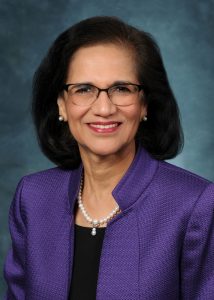Ex-RSNA chief calls for more international cooperation
Vijay M. Rao, MD, FACR is the David C. Levin Professor and Chair of the department of radiology at Thomas Jefferson University. She is also senior vice-president of Enterprise Radiology, Jefferson Health, and the immediate past president of the Radiological Society of North America. As she receives ESR Honorary Membership today, she looks back on 30 years of work in a field she describes as globally united.
Radiology has come a long way from the days of plain film hypocycloidal tomography in head and neck imaging, a subspecialty to which Prof. Rao has dedicated most of her career. Technological innovations such as ultrasound, CT, MRI and PET have revolutionised the field, allowing for earlier diagnosis and greater insights into the pathophysiology of a host of diseases and conditions.

Professor Vijay M. Rao from Philadelphia, immediate past president of the RSNA, will receive ESR Honorary Membership today during the Grand Opening.
Radiology continues to evolve from anatomic to more physiologic and functional assessment of disease processes, with more precise quantification and minimally invasive therapeutic options.
Rapid technological advances have led to tremendous growth in radiology along with associated costs. But the digital age has introduced a number of previously non-existent opportunities to transform radiology practice, using tools powered by informatics and machine learning (ML). “Radiologists should explore ways to utilise these technological advances to add value and reduce waste in healthcare,” she said.
Artificial intelligence (AI) and ML applications are valuable tools that make radiologists more effective and increase their contributions to personalised and precision medicine. “AI can assist radiologists at a time when we are challenged to provide imaging services that are faster, safer and affordable, as well as information that is quantitative and precise. These new technologies will improve workflows in our daily practice, freeing up time for us to better position ourselves as integral members of the patient’s healthcare team,” she said.
The move toward value-based imaging continues to be the biggest trend in the US, where emphasis is placed on volume when structuring radiology practice. “Policymakers lack understanding of imaging’s contribution to patient care and the extent of services that radiologists provide. That is why we have begun the necessary transition to a value-based model of care, where radiologists are actively consulting with patients and their referring physicians as part of the healthcare team,” she explained.
In research, she singled out papers on gene therapy for cancer, resting state fMRI studies of brain networks, PET radiotracers, biomarkers in lung cancer imaging, and the explosion of deep learning applications. But radiologists “have only begun to scratch the surface of what artificial intelligence and machine learning can do,” she said.
Prof. Rao is the first female chair of a clinical department at Thomas Jefferson University, a past president of the American Association for Women Radiologists, and immediate past president of the RSNA. She has been a champion of women in radiology, working to provide opportunities for networking and career development, increasing the visibility of women in radiology, and most importantly, supporting mentoring programmes.
“I would like to see more women pursue such positions, but my advice to both women and men would be to seek out mentors, network with your colleagues, join a society like the RSNA or the ESR and find ways to volunteer. Seek out opportunities to interact with your colleagues in other parts of the world. It is these experiences that help us to grow and gain the insights and knowledge we need to become strong leaders,” she said.
Prof. Rao graduated from All India Institute of Medical Sciences, India’s premier medical school, in New Delhi in 1973. She then completed her radiology residency in 1978 at Thomas Jefferson University Hospital and has remained on the faculty ever since. Her experience of two different cultures has enabled her to understand radiology on a more global scale.
“Exposure to both cultures has given me an appreciation of both global advances in radiology and also the wide differences in access to resources in healthcare,” she said.
Global collaborations fostered by the RSNA under her presidency, notably through RSNA Spotlight courses, have been particularly gratifying for her. “These collaborations with our international colleagues have been extremely rewarding. Through an international exchange of ideas, we are able to join forces with our colleagues throughout the world, so that our specialty continues to thrive.”
She attended the ECR for the first time in 2018 and was very impressed by the expansive congress and international scale. “I really enjoyed the opportunity to learn more about the ESR Meets countries, especially the cultural presentations. I was struck by the common issues that unite radiologists across the globe, and found it beneficial to share challenges and possible solutions with international colleagues,” she said.
She hopes the ESR will continue its international programmes with other societies, to provide its members with learning opportunities and global perspectives on the issues that affect their practices.


